
Table des matières
Creation of a dynamic access file (ADxx) via the eDARI portal
Access to the file
Creating this file is done via the eDARI portal www.edari.fr which requires that you have an account defined on this portal. If this is not the case, please see our documentation concerning the creation of an account on the DARI portal. From the homepage of the eDARI portal:
- You must first identify yourself via the link “Se connecter ou se créer un compte eDARI” (Connect or create an eDARI account) on the top right of the page:

- This opens a new page on which you choose the desired type of connection (Connection via an eDARI account or connection via the “Fédération Éducation-Recherche”.
- Once you are connected on the eDARI portal, you access the homepage of your user space (« Utilisateur »):
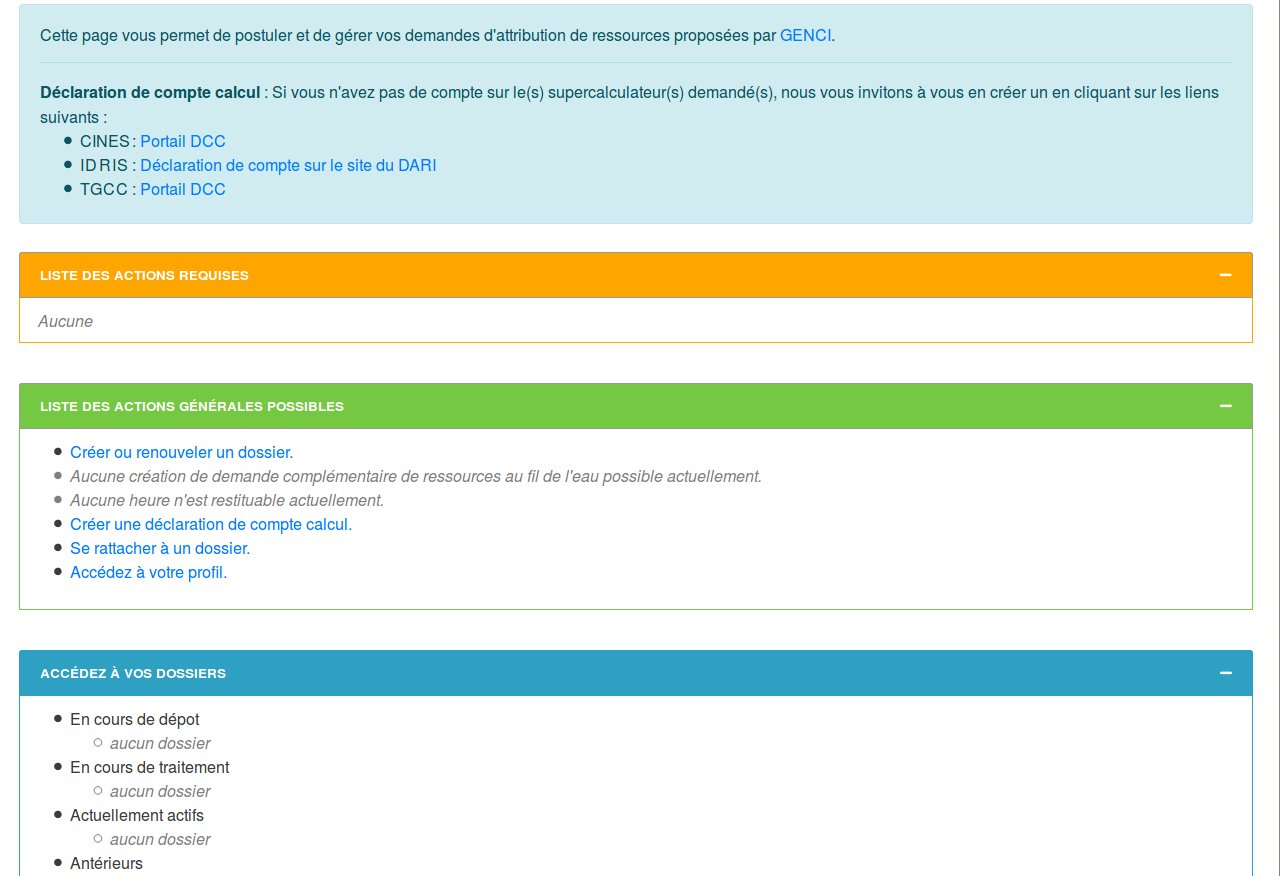
- You then click on the link “Créer ou renouveler un dossier” (Create or renew a file) found in the box under the green topbar LISTE DES ACTIONS GÉNÉRALES POSSIBLES.
- Then, on the page which you have just opened, click on the blue button “Création d'un nouveau d'un nouveau dossier” (Creation of a new file):
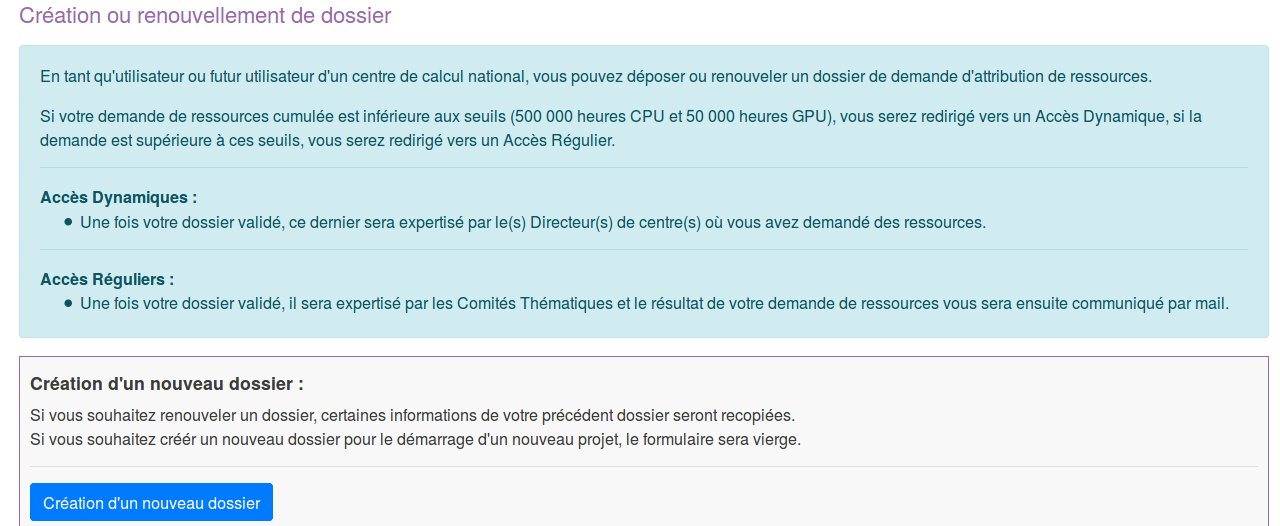
REMEMBER: If your ACCUMULATED resource request for the three national centres is inferior to the defined thresholds (500 000 CPU hours and 50 000 normalized GPU hours), you will be redirected to Dynamic Access (AD); if your request is superior to these thresholds, you will be redirected to Regular Access (AR). Dynamic Access: Once you have validated your file submission, it will receive an expert assessment by the Director(s) of the centre(s) where you have requested resources; if accepted, the hours will be available without delay. Regular Access: Once you have validated your file submission, it will be subject to an expert assessment by the Thematic Committees during the bi-annual project calls; the result of your request will be communicated to you by e-mail. - The present document describes the creation of a dynamic access (AD) file for the AI or HPC communities.
- After reading and validating the page on management of your personal data, click on the blue link “Envoyer et passer à la suite” (Send and continue) to arrive on the first page of the file entry.
Completing the file
Page 1: Project
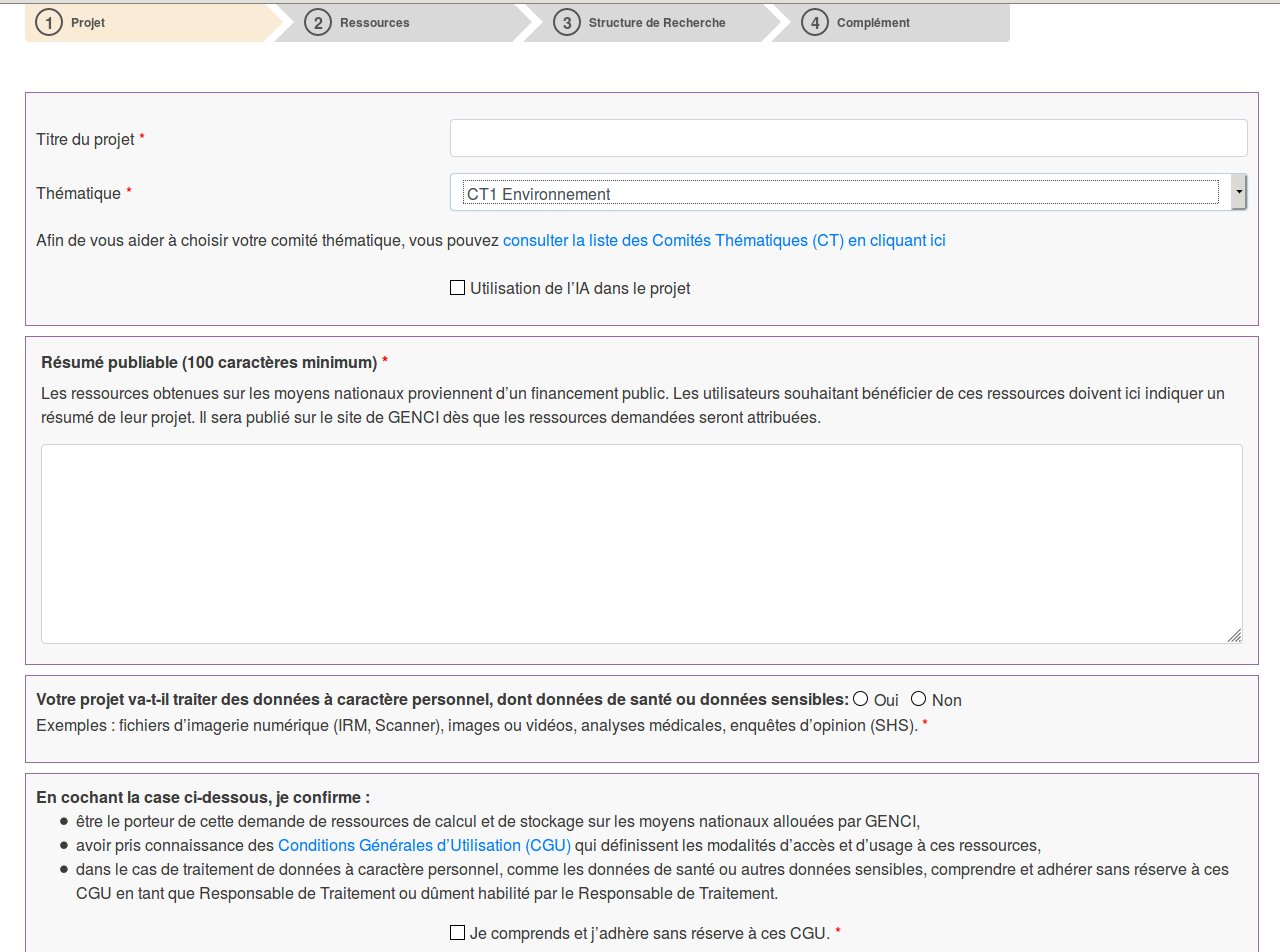 |
All the titles marked with a red asterick must be completed. In the section “Description scientifique du projet”, it is important that your scientific project be described clearly in order to facilitate the expert scientific evaluation, especially if you are requesting a large number of hours.
IMPORTANT: Be careful to choose the correct « Thématique (CT)» (Thematic committee)! You may see the list of CTs by clicking on the link provided. This choice cannot be modified after all the information on the page is saved.
For Artificial Intelligence, choose CT10 and don't forget to enter the application domaine of your project on the page which opens.
Whether your project uses the GPU or the CPU partition of Jean Zay, and whether this is in the AI or HPC domaine, if you will process sensitive data (audio, video, health data, etc.), PLEASE TICK “OUI” for the question “Votre projet va-t-il traiter des données à caractère personnel” (Will your project process personal data?). After clicking on the blue button “Suivant” at the end of the project section, you will then be directed to a specific page to declare the person responsible for the processing (this can be yourself or another designated person in your laboratory or research team). In addition, you have the optional possibility of completing a questionnaire about the anticipated data processing: We strongly urge you to complete this questionnaire in order to accelerate the inquiry we will be conducting into the project.
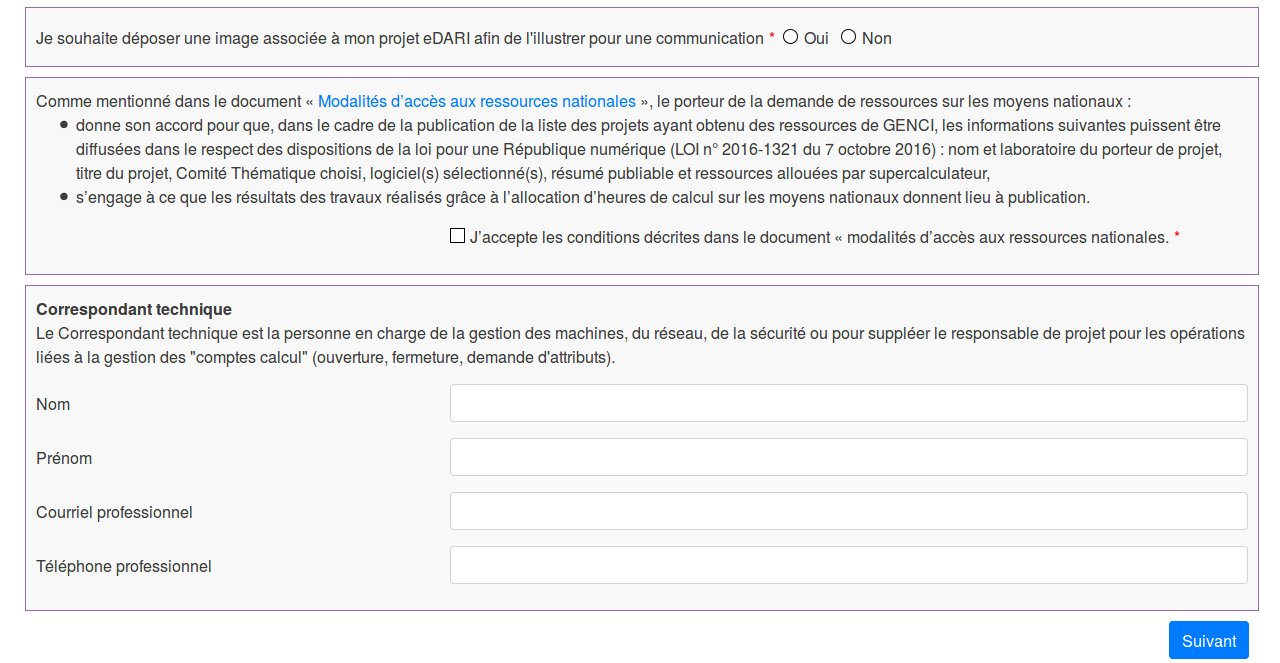 |
It is optional to “Déposer une image” (Submit an image) in above box. It allows GENCI to associate an image with your file when publishing the list of projects receiving resources at the national computing centres. If you tick « Oui », you will be directed to another page to validate and select an image.
The information about a « correspondant technique » is not automatically used by IDRIS. AFTER your file is accepted and AFTER your computing account associated to the project is accepted, you should use the (Administration Form for Login Accounts - FGC) in order to provide this information to IDRIS. On page 1 of this form, complete the section « Add or delete a deputy project manager for an existing project ».
Page 2: Resources
After having completed the information requested about your project, you can enter the needed resources on Page 2:
 |
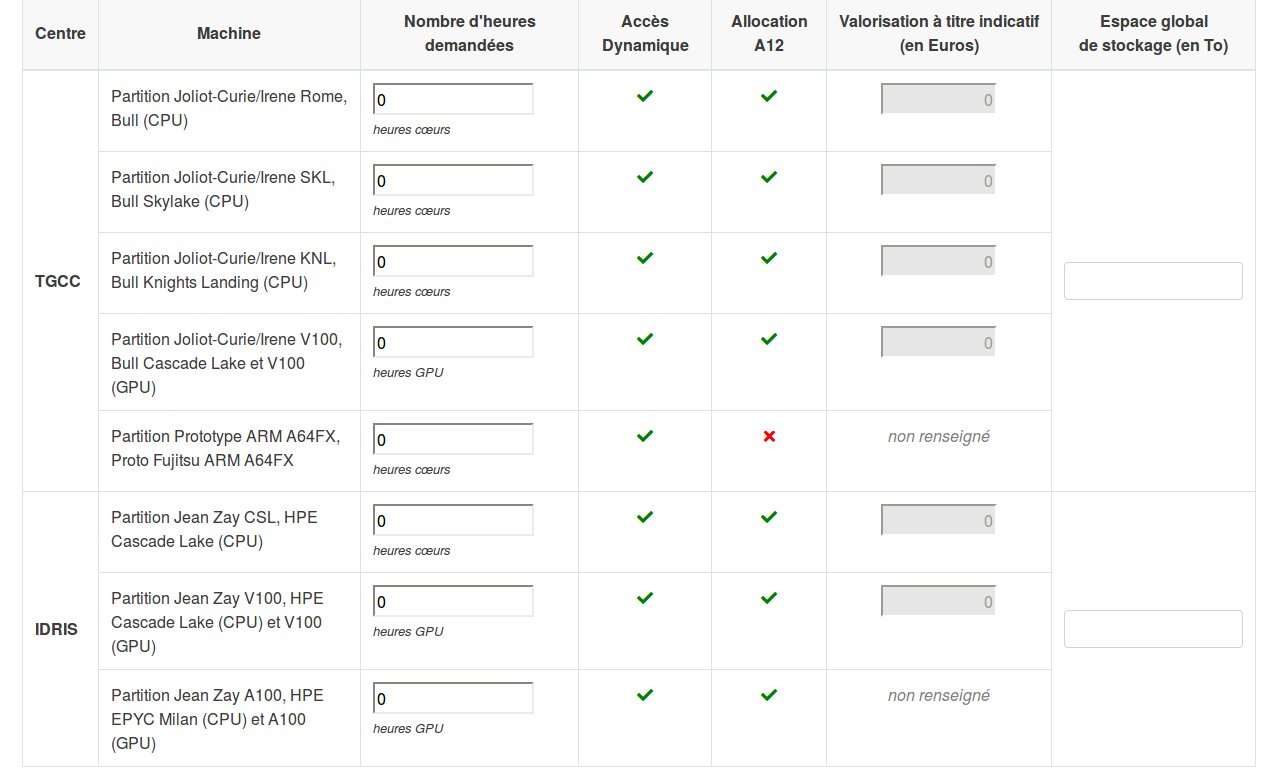 |
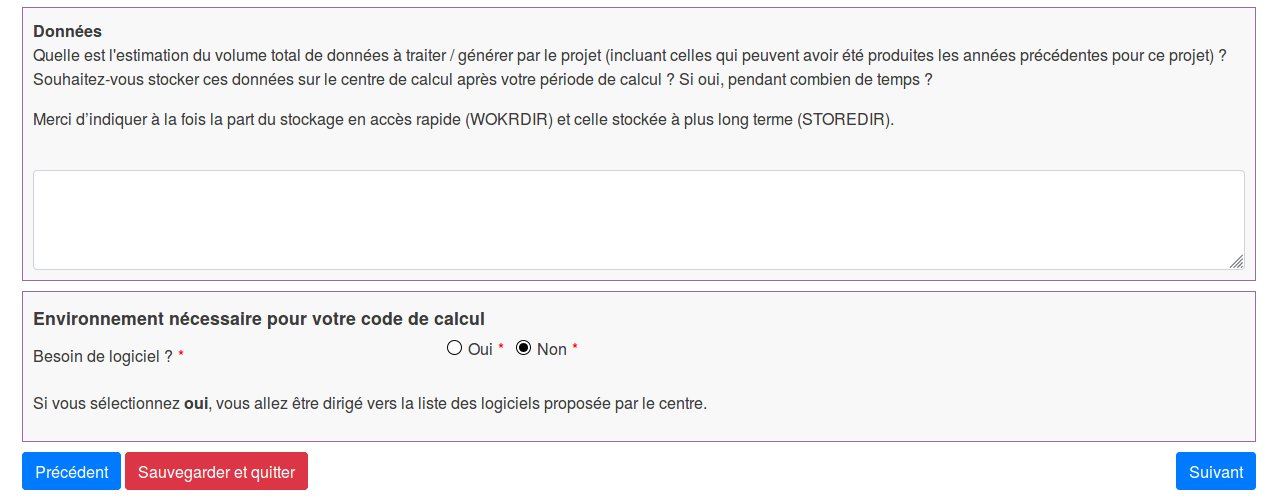 |
You can request hours in the three computing centres but in this documentation, we will focus on the hours requested at IDRIS. Whether this is for the AI or HPC community, you can request at the same time, the CPU hours (Partition Jean Zay CSL in first space), the GPU hours (Partition Jean Zay V100 in second space) and GPU hours on the most recent partition (Partition Jean Zay A100 in third space). IMPORTANT: The GPU A100 partition will not be open to users until 1 June 2022.
On the right, the column “Espace global de stockage” (Global storage space in GB) is to be completed for specific storage needs you may have throughout the duration of the project. ATTENTION: This information is mandatory.
On the remainder of this page, you can provide information about the quantity of data to be produced, if these data should be stored at IDRIS and your software needs. (“Données” (Data): What is the estimation of the total volume of data to treat/generate by the project [including data which could have been produced for this project during preceding years]? Do you wish to store these data at the computing centre after your computation period? If yes, for how long?)
The part “Environnement necessaire …” asks if you need certain software to run your code. If you respond “Oui”, you will be redirected to a specific page which dynamically lists the software available on the partitions which you have requested; in the example below, the Jean Zay CSL (CPU) hours and the Jean ZAY A100 (GPU) hours:
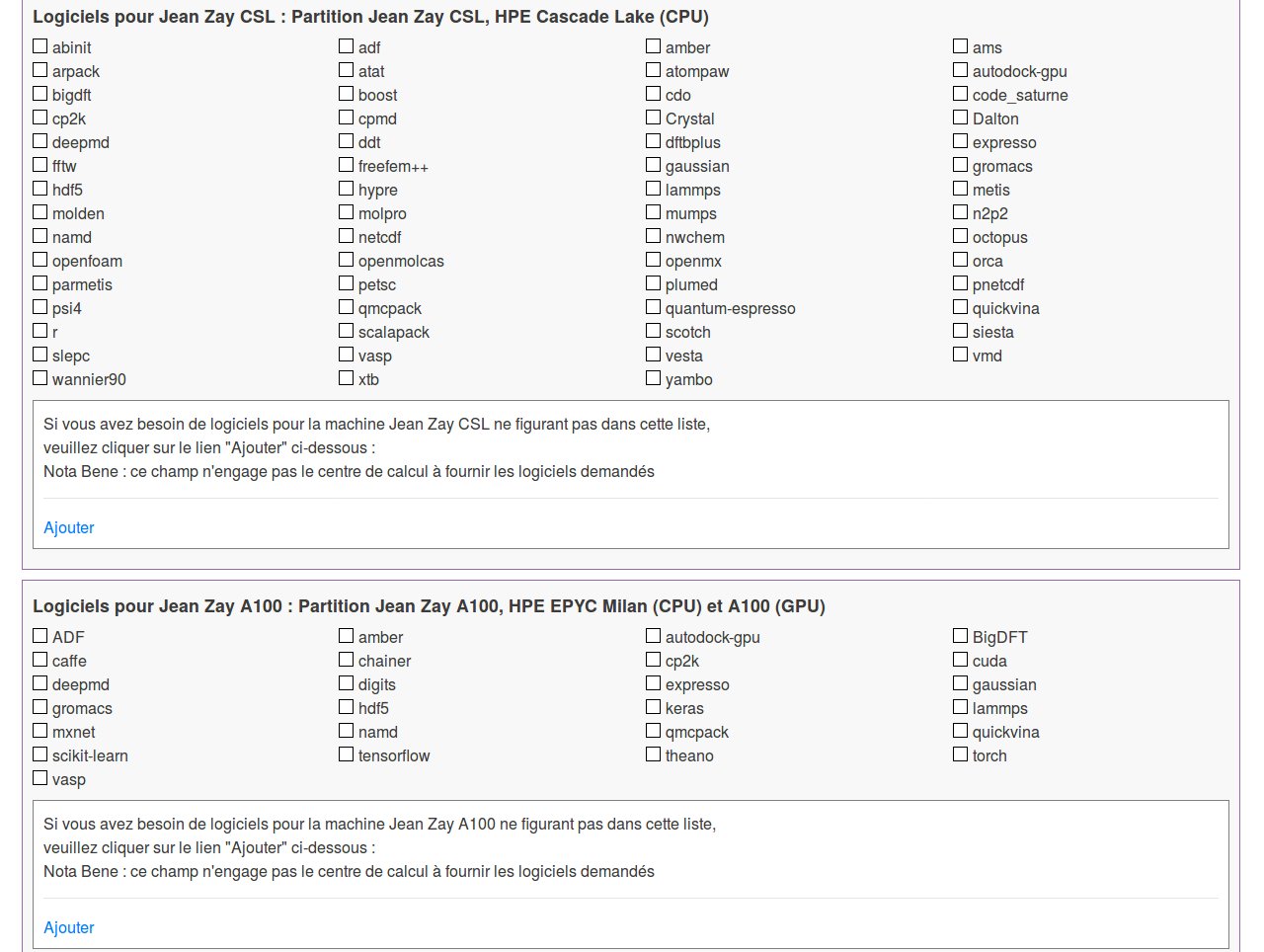 |
Tick the software on the list which you need. If you need a software which is not on the list, you may click on the blue link “Ajouter” (Add) and indicate the software needed; however, IDRIS cannot guarantee being able to install it.
After clicking on the blue button “Suivant ” (Next) on the bottom of page 2, the third page will open on which you will provide information about your research structure.
Page 3: Research structure
 |
In this step, the national directory of research structures (RNSR) is utilised which references thousands of public and private research structures in France. Enter the first letters of your laboratory, organisation or research structure in the search box on the right (“Rechercher”) and if this displays a result, click on it to display a summary page of information about your research structure. If necessary, you can modify the postal or telephone contact details. If the director of your structure is identified, this will appear at the bottom of the page but it cannot be modified. If your structure is absent from this file or if you are part of a business company, use the blue button, “Je ne trouve pas ma structure de recherche” (I cannot find my research structure), at the bottom of the page:
 |
Page 4: Description
On the fourth and last file entry page, you should indicate the number of CPUs and or GPUs which you think you will use for your simulations, if you have the possibility of migrating your applications and environments to one (or more) supercomputers of another centre in case of very high demand on the chosen computer, and the timing for using the allocated computing hours (continually throughout the year, by periods, etc.):
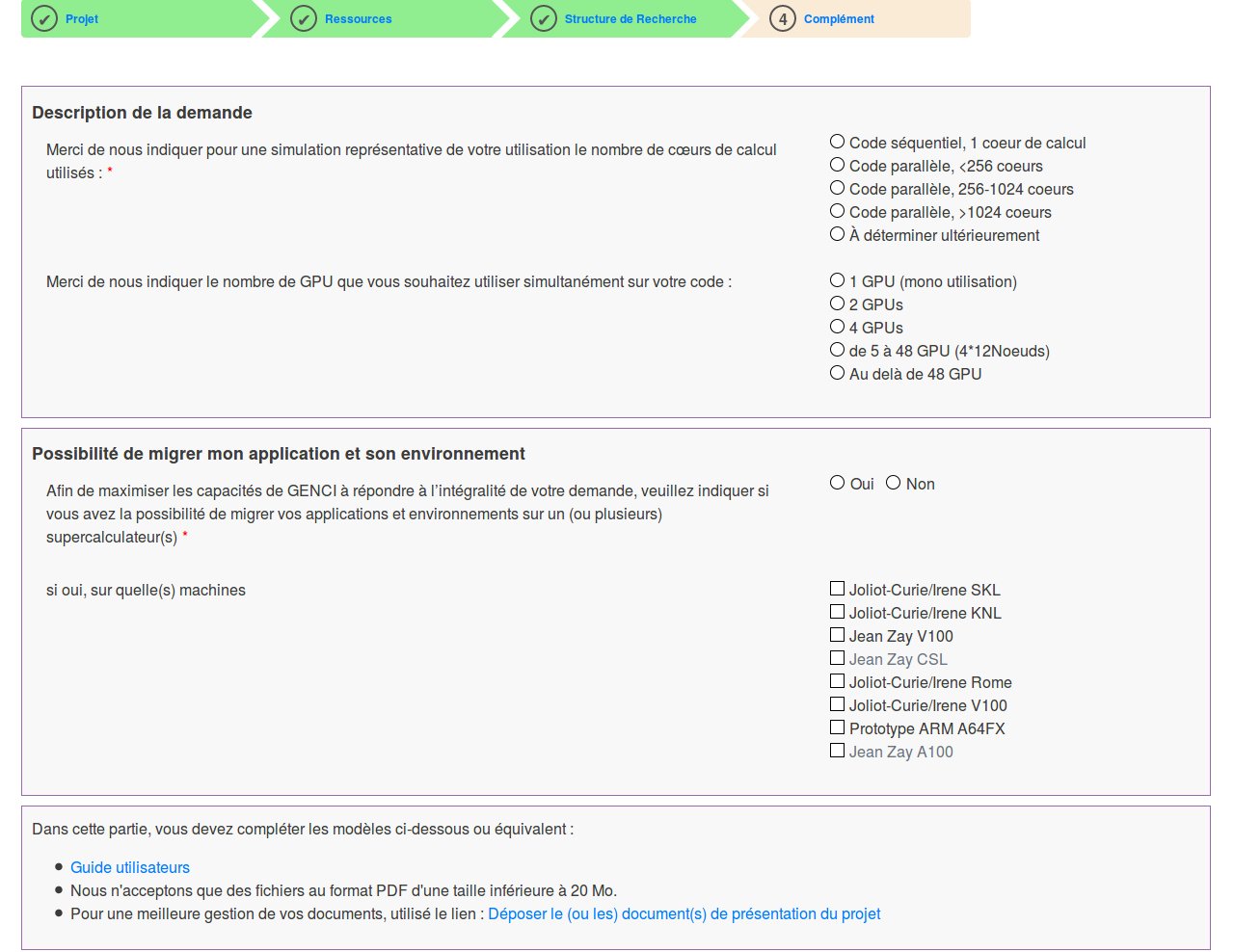 |
Then you click on the blue “Terminer” button to return to the homepage of your User Space which will have changed dynamically.
Return to the User Space
You will find here the following information about your dynamic access file:
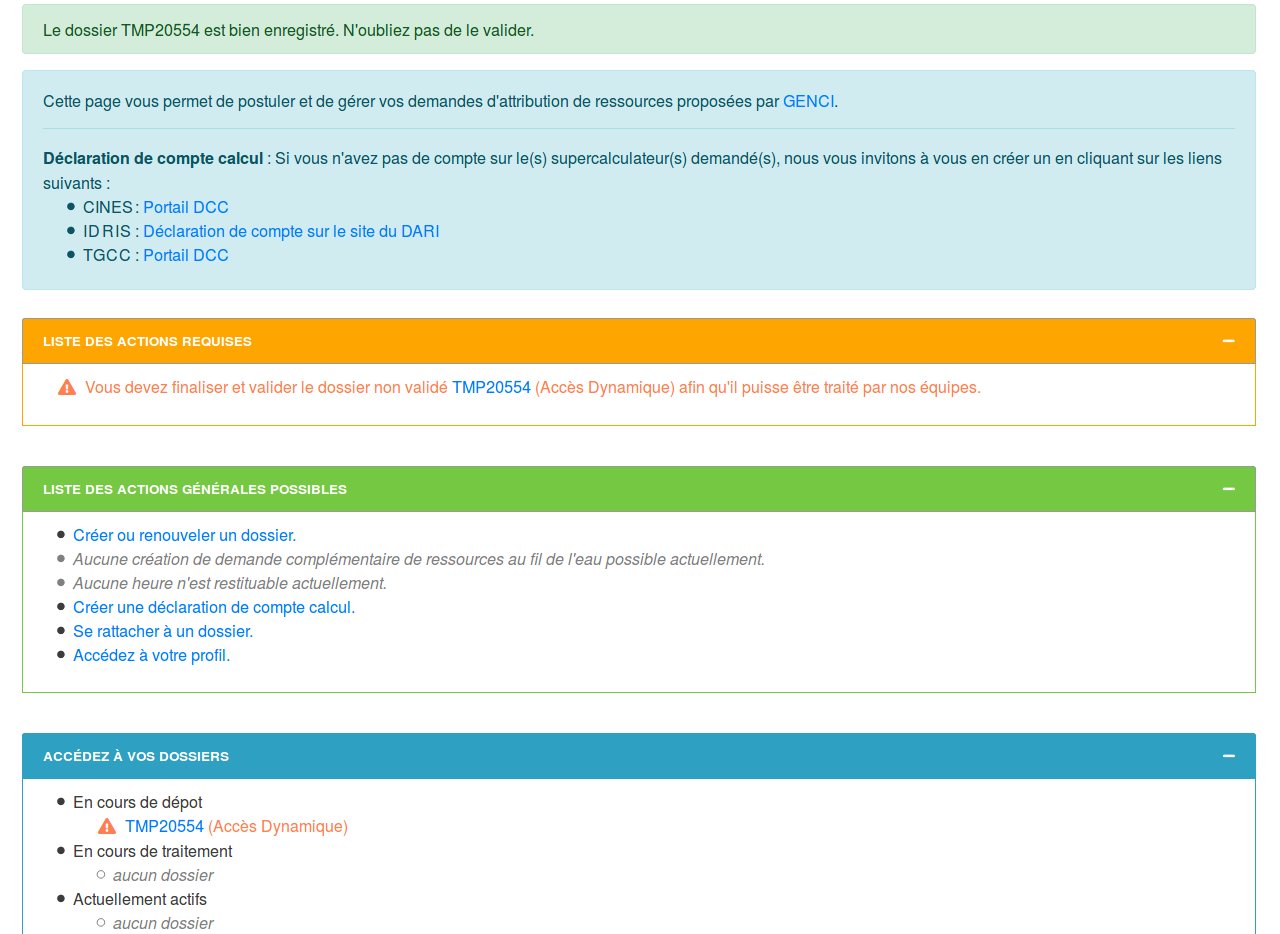 |
Comment: At this stage of the procedure, your file has not yet been validated and, therefore, will not yet have been examined for an allocation of hours. To do this, click on the temporary file number in blue found in the orange box “LISTE DES ACTIONS REQUISES”. This will open the following menu:
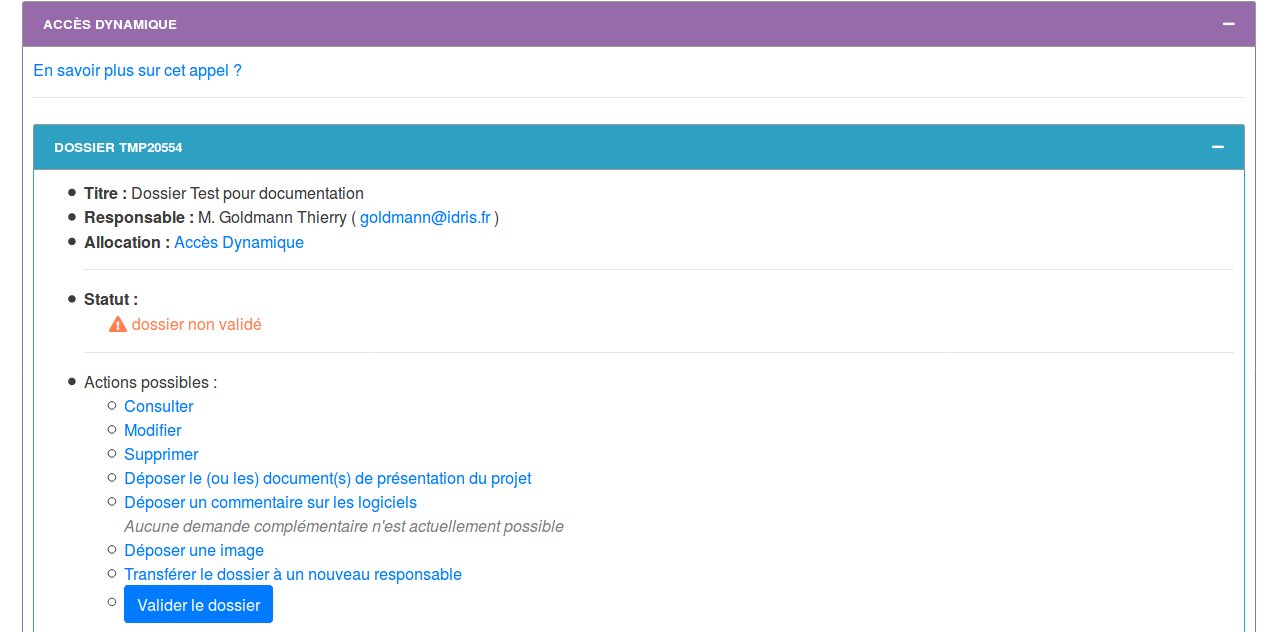 |
The title in the purple topbar is “ACCÈS DYNAMIQUE” because the hours requested are less than the threshold for Regular Access. From this menu, you can consult, modify (except for the thematic committee) or delete the file. You can also submit optional explanatory documents about your project (in PDF format only), submit a commentary about a software (you would like a particular version or a version compiled with modifications done in your laboratory), or transfer the file to another project manager.
If you do not have other information to add, or corrections to make, click on the blue button “Valider le dossier”. Then, the following will then appear dynamically on the top of your User Space (« Utilisateur ») menu on the eDARI portal:
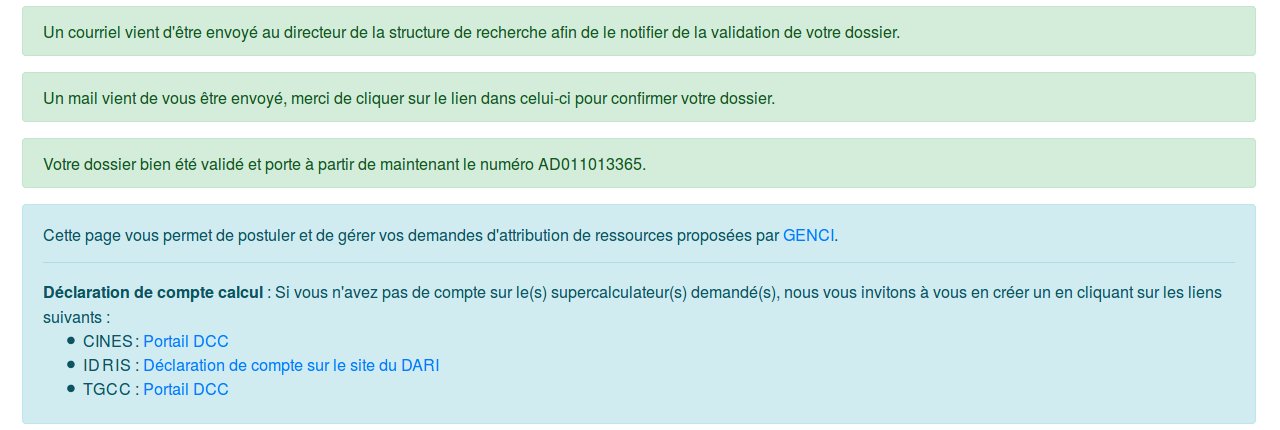 |
Your permanent file number appears in the third green box. If you do not have a computing account on the requested supercomputer(s), you may create one by clicking on the links provided in the blue box.
Important:
- These three green boxes will only appear if both the director of your research structure and yourself are enrolled in the Education-Research identity federation,(FER). Both you and your director will then receive an e-mail containing a link which must be clicked on in order to authenticate yourselves (dispensing you from having to submit signatures) and which finalises the procedure.
- However, if you and your director are not both enrolled in the identity federation, only the last green box will appear indicating the identification number of your dynamic access file.
- In this case, see the orange box below : “LISTE DES ACTIONS REQUISES”. « In order for your resource request to be considered, you must submit on the site the signed signature document (visa) for the file below. » This is followed by the clickable file number and whether it is Dynamic Access or Regular Access (in parentheses).
 |
- By clicking on this file number, a box with a blue topbar will dynamically appear at the bottom of your User Space page containing a summary of your file status and indicating the date when you validated your file and that the « Visa » (signature document) has not yet been submitted to IDRIS.
|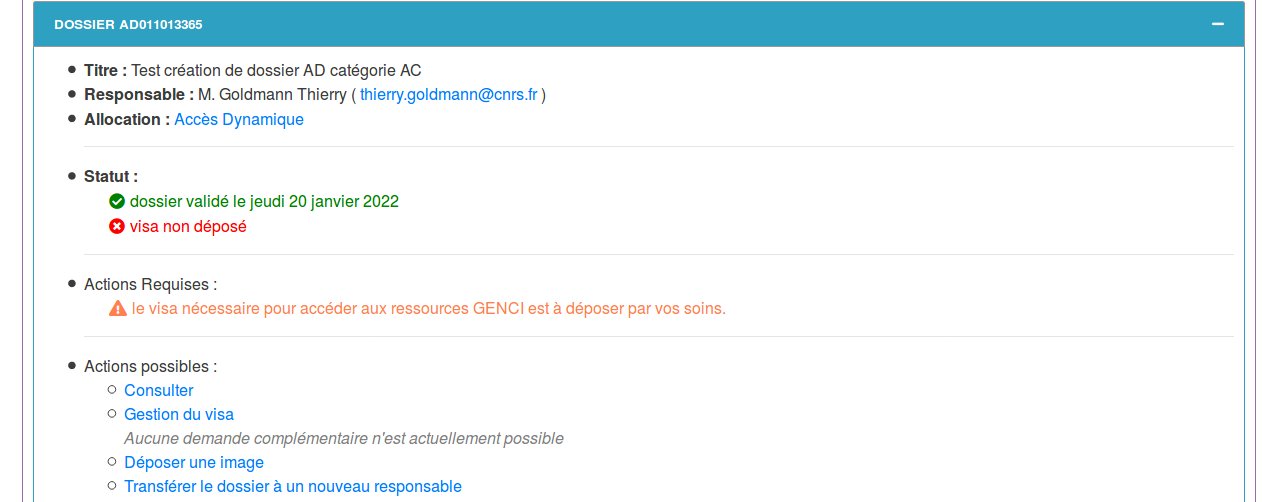 |
|
Click on the “Gestion du Visa” link, and then on “Télécharger le visa au format PDF”. You need to print this signature document, sign it (and have it signed by the director of your research structure if this is indicated in this document), and then scan it.
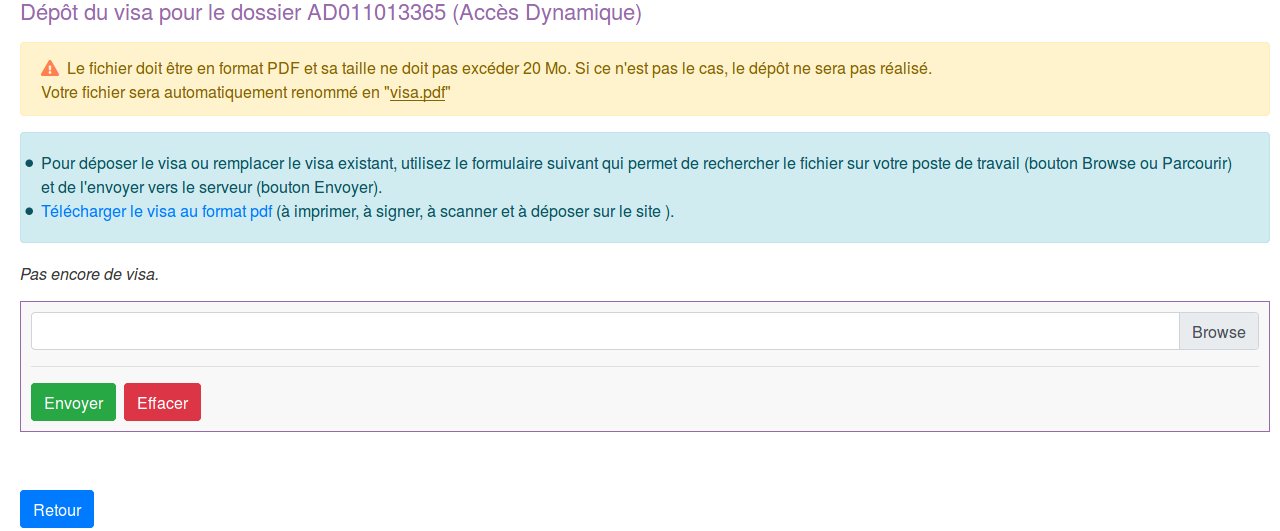 |
|
Submit the scanned document (which cannot exceed 20 MB) in PDF format by using the « Browse » button in the dialogue window. If the signed visa is not submitted, your file WILL NOT OBTAIN EXPERT EVALUATION by IDRIS management. Once the visa is sent (green button « envoyer »), you will have the following information which confirms that the visa was submitted:
 |
In addition, higher on your user menu, a space with an orange topbar will be displayed stating that no other action is required of you.
 |
If you click on your file number in the blue box at the bottom of your User space:
 |
You will have the confirmation that your signature document has been submitted (« visa déposé ») for your computing hours request.
 |
IDRIS will verify that the necessary signatures are on the document. If this is the case, the visa will be accepted and the expert evaluation procedure by IDRIS management will begin.
You can submit more than one dynamic access file. The duration of a Dynamic Access file is for one year. At the end of this period, the file can be renewed. .
If you have any problems with this procedure, please contact IDRIS by e-mail at the following address: gestutil AT idris POINT fr. If you encounter a technical error, please send an e-mail to the following address: svp AT cines POINT fr.
